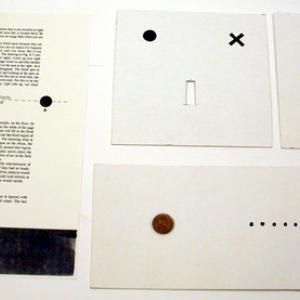College of Liberal Arts & Sciences
6J10.30 - Blind Spot
At a distance of about 50 cm., cover one eye and look at the coin on the blind spot chart. Slowly move your gaze from the coin to each of the spots in turn. When the right spot is looked at the coin will seem to disappear from view.
- Camille L. Wainwright, "An Empirical Verification", TPT, Vol. 37, #9, Dec. 1999, p. 517.
- Jeff Sanny, "Measuring the Diameter of Your Blind Spot", TPT, Vol. 37, #6, Sept. 1999, p. 348.
- Andrew DePino Jr., "The Disappearing Student", TPT, Vol. 36, #8, Nov. 1998, p. 491.
- David R. Lapp and James E. Keenan, "Cow's Eye Dissection in the Physics Lab", TPT, Vol. 29, #8, Nov. 1991, p. 502.
- Adolf Cortel, "Simple Experiments on the Physics of Vision: The Retina", Physics Education, Vol. 40 #4, July 2005, p. 325.
- N. Farkas, K. M. Donnelly, P. N. Henriksen, and R. D. Ramsier, "The Blind Spot: Re-Educating Ourselves About Visual Images", Physics Education, Vol. 39, #3, May 2004, p. 294.
- "O-580. Blind Spot", DICK and RAE Physics Demo Notebook.
- Paul Doherty and Don Rathjen, "Blind Spot", The Cheshire Cat, p. 21.
- "How to Find the Blind Spot in the Eye", The Boy Scientist, p. 188.
- Jearl Walker, "7.3, Decapitation with the Blind Spot", The Flying Circus of Physics Ed. 2, p. 305.
- Janice VanCleave, "Vanishing Ball", Biology for Every Kid, p. 164.
- Janice VanCleave, "69. Vanishing Ball", Janice VanCleave's 201 Awesome, Magical, Bizarre, & Incredible Experiments, p. 38.
- Raymond Bruman, "Blind Spot", Exploratorium Cookbook I, p. 36.1 - 36.2.
- Stan Gibilisco, "The Blind Spot", Puzzles, Paradoxes, & Brain Teasers Optical Illusions, Vol. 4.
- C. Harvey Palmer, "Experiment A18: Some Properties of the Human Eye", Optics - Experiments and Demonstrations, John Hopkins Press, 1962.
- Martin Keen, "Experiments With Human Senses", Let's Experiment, 1968, p. 153 - 155.
- UNESCO, "B. Your Senses", 700 Science Experiments for Everyone, p. 207 - 209.
- Sara Stein, "Brain Readouts", The Science Book, p. 191.
- Tik L. Liem, "Are We Partially Blind?", Invitations to Science Inquiry - Supplement to 1st and 2nd Ed. p. 149.
Disclaimer: These demonstrations are provided only for illustrative use by persons affiliated with The University of Iowa and only under the direction of a trained instructor or physicist. The University of Iowa is not responsible for demonstrations performed by those using their own equipment or who choose to use this reference material for their own purpose. The demonstrations included here are within the public domain and can be found in materials contained in libraries, bookstores, and through electronic sources. Performing all or any portion of any of these demonstrations, with or without revisions not depicted here entails inherent risks. These risks include, without limitation, bodily injury (and possibly death), including risks to health that may be temporary or permanent and that may exacerbate a pre-existing medical condition; and property loss or damage. Anyone performing any part of these demonstrations, even with revisions, knowingly and voluntarily assumes all risks associated with them.
